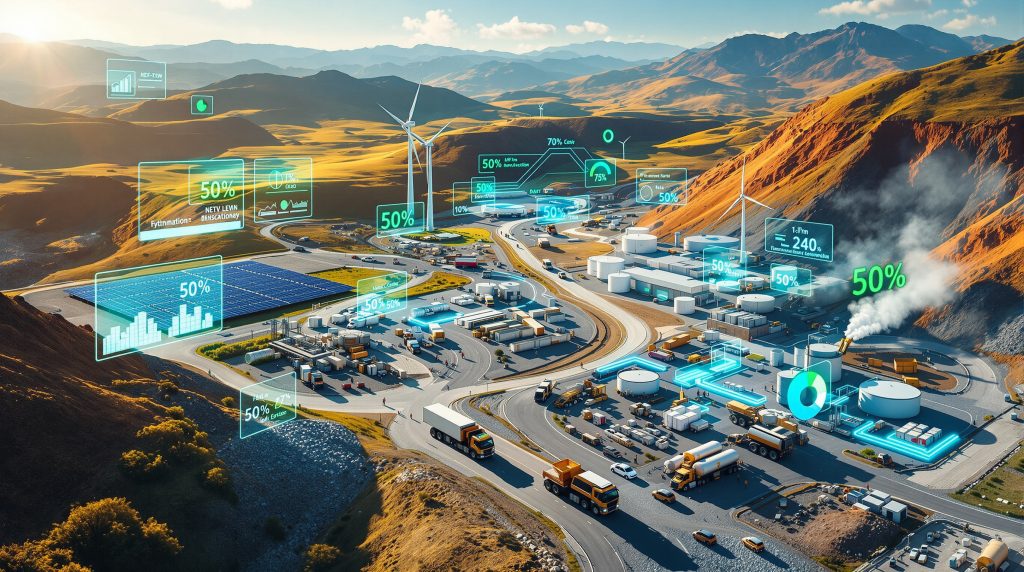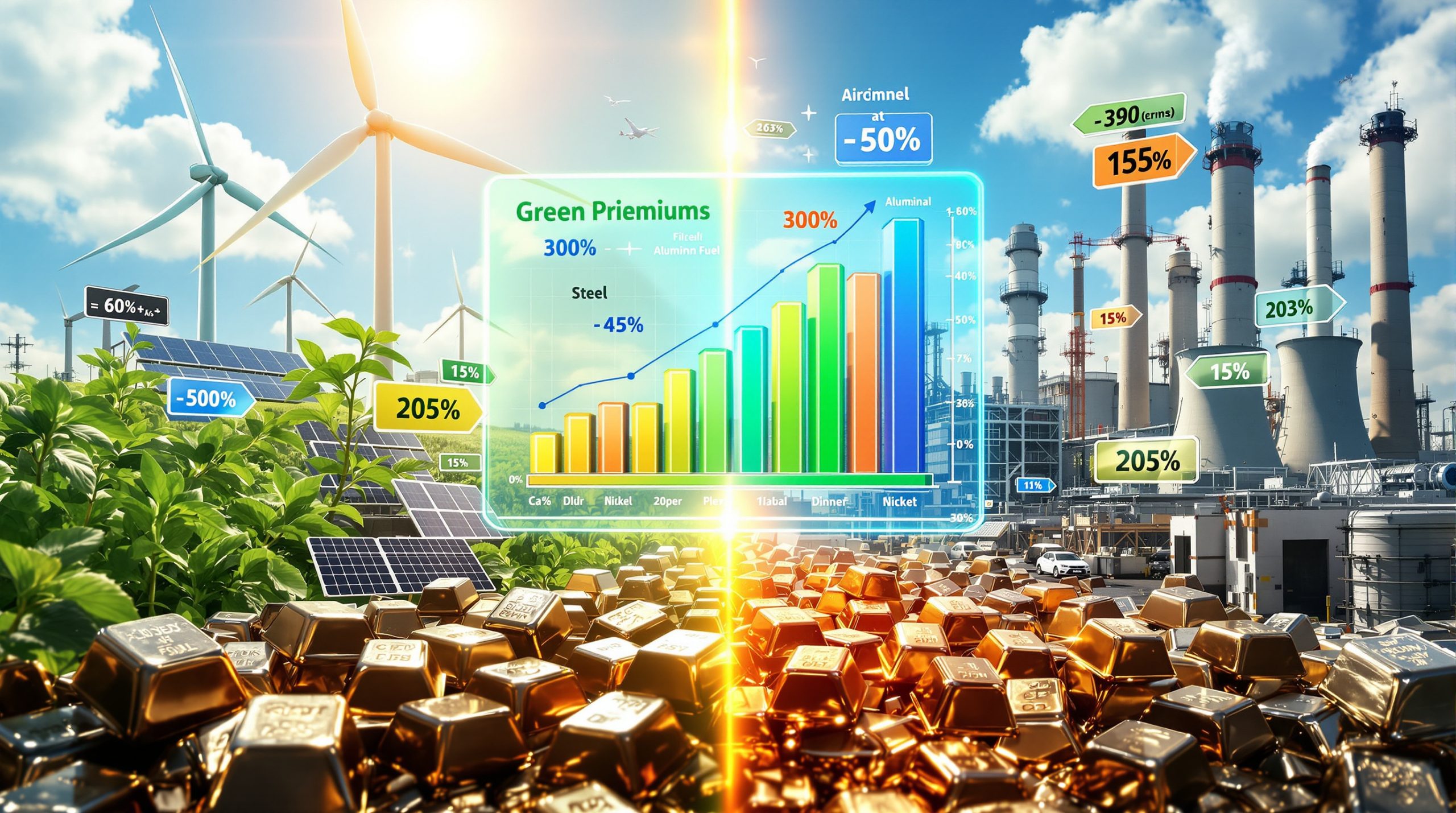The Carbon Challenge Facing Modern Mining Operations
Mining operations worldwide confront an unprecedented challenge in achieving net-zero emissions by 2030. The sector contributes approximately 8% of global greenhouse gas emissions, yet must simultaneously increase production to meet surging demand for critical minerals essential to the broader energy transition. This paradox creates unique pressures requiring innovative solutions that balance environmental responsibility with operational efficiency.
Current progress reveals concerning gaps in decarbonisation momentum. Industry analysis indicates mining achieves only 2% annual emissions reduction, representing roughly half the rate necessary to align with 1.5 degrees Celsius climate targets. Without accelerated transformation, mining operations risk falling short of greenhouse gas reduction goals by nearly 40%.
The challenge intensifies as global demand for critical minerals continues expanding rapidly. Since 2017, the energy sector has tripled its lithium requirements, while cobalt demand has increased by 70% and nickel requirements have risen by 40%. By 2030, current mining operations may only supply approximately half of the cobalt and lithium the world requires for clean energy transitions.
Understanding Emission Sources Across Mining Operations
Decarbonising mining operations requires comprehensive understanding of emission sources throughout the extraction and processing cycle. Mining emissions originate from multiple operational areas, each demanding targeted intervention strategies tailored to specific operational contexts.
Direct Operational Emissions
Heavy machinery represents the largest contributor to direct emissions in most mining operations. Diesel-powered haul trucks, excavators, and drilling equipment generate substantial carbon outputs during daily operations. Transportation activities, particularly haul truck operations, can account for up to 50% of total site emissions in open-pit mining operations.
On-site power generation using fossil fuel sources creates additional direct emissions. Many remote mining locations rely on diesel generators for consistent power supply, contributing significantly to overall carbon footprints. Processing facilities requiring high-temperature operations for ore concentration and refining generate substantial emissions through energy-intensive heating and chemical processes.
Ventilation systems maintaining underground air quality represent another significant emission source. These systems operate continuously to ensure worker safety, consuming substantial energy while removing potentially hazardous gases from underground workings.
Indirect Energy Consumption
Grid electricity sourced from coal-fired power stations creates substantial indirect emissions for mining operations. In regions like South Africa, where coal provides approximately 70% of power supply, mining companies face limited options for reducing grid-based emissions without significant infrastructure investment.
Supply chain transportation and logistics networks generate additional indirect emissions through material movement, equipment transport, and personnel mobility. Equipment manufacturing and replacement cycles contribute to lifecycle emissions, particularly as mining companies upgrade ageing fleet systems.
Site construction and infrastructure development create substantial one-time emissions during mine establishment and expansion phases. These activities involve concrete production, steel fabrication, and heavy construction equipment operation over extended periods.
Electrification Strategies for Mining Fleet Transformation
Electric-powered mining equipment represents the most immediate pathway to substantial emission reductions across operational sites. Modern mining companies are transitioning entire fleets to battery-electric alternatives, delivering both environmental and operational benefits through advanced technology integration.
Battery-Electric Vehicle Implementation
Mining sites implementing battery-electric fleets report multiple operational advantages beyond emission reductions. Electric vehicles demonstrate reduced fuel costs and eliminate exposure to diesel price volatility, creating predictable operational expenses over extended periods.
Lower maintenance requirements compared to diesel engines reduce operational complexity and associated costs. Electric motors contain fewer moving parts than internal combustion engines, resulting in extended operational intervals between major service requirements.
Underground mining operations particularly benefit from improved air quality through eliminated diesel particulates. This improvement reduces ventilation energy requirements while enhancing worker safety and operational conditions throughout underground workings.
Enhanced worker safety extends beyond air quality improvements. Electric equipment operates with significantly reduced noise pollution, improving communication capabilities and reducing long-term hearing damage risks for operational personnel.
However, full electrification introduces new dependencies on power reliability. As extreme weather events increasingly disrupt electrical grids, power outages pose material risks to production continuity and long-term energy stability for mines relying entirely on electric power systems.
Trolley-Assisted Haulage Systems
Large-scale mining operations implement overhead power lines to support heavy-duty transportation networks, creating hybrid systems combining electric power with operational flexibility.
Trolley systems provide continuous power supply for high-capacity vehicles operating along established routes. This approach reduces battery weight requirements for equipment while maintaining consistent performance across varying terrain conditions.
Integration with renewable energy microgrids enables trolley systems to operate using clean power sources, maximising emission reduction benefits while maintaining operational reliability during variable renewable generation periods.
Renewable Energy Integration in Remote Mining Locations
Mining companies develop sophisticated renewable energy solutions to power entire operational sites independently, reducing reliance on fossil fuel generation and grid connectivity limitations in remote locations.
Hybrid Renewable Microgrids
Advanced energy systems combine multiple renewable sources to ensure consistent power delivery across mining operations. These integrated systems balance variable renewable generation with operational power requirements through sophisticated control systems.
| Energy Source | Capacity Range | Primary Benefits |
|---|---|---|
| Solar Arrays | 10-100 MW | Daytime peak power generation |
| Wind Turbines | 20-150 MW | Consistent baseload capacity |
| Battery Storage | 5-50 MWh | Grid stabilisation and backup power |
| Backup Generators | 5-25 MW | Emergency power during maintenance |
Solar arrays provide predictable daytime power generation aligned with peak operational periods. Wind turbines offer consistent baseload capacity during variable weather conditions, creating complementary generation profiles throughout daily operational cycles.
Battery storage systems stabilise microgrids during rapid load changes and provide backup power during temporary generation shortfalls. Emergency generators maintain critical systems during planned maintenance or unexpected equipment failures.
Proven Renewable Integration Success
The Agnew Gold Mine in Western Australia demonstrates successful large-scale renewable energy adoption through strategic infrastructure investment. The operation now sources up to 60% of its power from renewable energy through hybrid solar and wind systems.
This hybrid microgrid combines multiple renewable sources with energy storage to maintain operational continuity while reducing dependence on diesel generation. The system demonstrates that remote mining operations can achieve substantial renewable energy integration without compromising production reliability.
The Agnew renewable energy microgrid represents a proven model for mining operations seeking to reduce reliance on fossil fuel generation while maintaining consistent power delivery in challenging remote environments.
Digital Technology Applications in Mining Decarbonisation
Advanced digital systems enable precise energy management and operational optimisation across mining sites, creating opportunities for substantial emission reductions through data-driven decision making and automated control systems.
Artificial Intelligence and Machine Learning Integration
Furthermore, AI in mining systems continuously analyse operational data to identify emission reduction opportunities across mining operations. These systems process vast datasets from equipment sensors, environmental monitors, and production systems to optimise energy consumption patterns.
Predictive maintenance scheduling prevents equipment inefficiencies that increase energy consumption and emissions. Machine learning algorithms analyse equipment performance data to identify optimal maintenance intervals, reducing unexpected failures and associated emission spikes.
Real-time route optimisation for transportation fleets reduces fuel consumption and operational emissions. Advanced algorithms continuously adjust vehicle routing based on traffic conditions, equipment availability, and operational priorities to minimise total energy requirements.
Dynamic ventilation control systems adjust airflow based on underground activity levels, reducing energy consumption while maintaining safety standards. These systems monitor air quality continuously and adjust ventilation rates to match actual requirements rather than maintaining maximum airflow constantly.
Energy consumption forecasting and load balancing optimise power distribution across mining sites. These systems predict energy requirements based on operational schedules and adjust power generation to match demand patterns efficiently.
Digital Twin Technology Applications
Virtual replicas of mining operations enable comprehensive testing of decarbonisation strategies before implementation, reducing risks associated with operational changes while optimising emission reduction approaches.
Digital twin technology enables operators to test haul cycle optimisations and reduce equipment idle emissions through virtual scenario testing. These systems model operational changes to predict energy consumption impacts before implementing physical modifications.
Risk-free testing of new operational procedures enables mining companies to evaluate decarbonisation strategies without disrupting production. Digital twins simulate various operational scenarios to identify optimal approaches for emission reduction while maintaining operational efficiency.
Accurate prediction of energy consumption changes supports investment decision-making for renewable energy and electrification projects. These systems model the impacts of technology adoption to quantify expected emission reductions and operational benefits.
Financial Strategies Supporting Decarbonisation Investments
Substantial capital investment requirements necessitate innovative financing approaches for comprehensive decarbonisation programs. Mining companies implement diverse financial mechanisms to support clean technology adoption while maintaining operational profitability.
Internal Carbon Pricing Mechanisms
Leading mining organisations implement internal carbon pricing to factor emission costs into investment decisions. This approach supports capital allocation toward renewable energy projects, electrification initiatives, and digital optimisation tools by quantifying emission costs within financial analyses.
Internal carbon pricing creates clear financial incentives for low-carbon technology adoption throughout mining operations. These mechanisms evaluate investment opportunities based on total lifecycle costs including estimated carbon impacts, driving decisions toward cleaner alternatives.
Enhanced preparation for future carbon taxation policies positions companies advantageously as regulatory frameworks evolve. Internal pricing mechanisms enable organisations to understand potential impacts of external carbon pricing before implementation, supporting strategic planning efforts.
Competitive advantages in ESG-focused investment markets result from demonstrated commitment to emission reduction. Companies implementing comprehensive carbon pricing attract institutional investors prioritising environmental performance in portfolio allocation decisions.
Green Finance and Sustainability Bonds
In addition, mining companies increasingly access specialised financial instruments designed to support environmental initiatives, creating dedicated funding streams for decarbonisation projects. These capital raising methods provide essential resources for clean technology adoption.
Sustainability-linked loans with performance-based interest rates incentivise emission reduction achievements through financial rewards. These instruments tie borrowing costs to environmental performance metrics, creating direct financial benefits for successful decarbonisation efforts.
Green bonds specifically allocated to renewable energy projects provide dedicated funding for clean technology adoption. These instruments enable mining companies to access capital markets specifically interested in environmental investments.
Government grants and subsidies for clean technology adoption reduce upfront investment requirements for decarbonisation projects. These programs support demonstration projects and initial technology deployment through direct financial assistance.
Critical Challenges Constraining Decarbonisation Progress
Despite significant technological progress, mining companies encounter substantial obstacles in achieving comprehensive emission reductions within required timeframes, particularly in remote operational environments.
Infrastructure and Location Constraints
Remote mining locations often lack access to reliable renewable energy infrastructure and grid connections, creating substantial challenges for electrification and clean power adoption. These geographic constraints require substantial infrastructure investment to enable comprehensive decarbonisation.
Limited grid connectivity in remote mining regions necessitates standalone power generation systems, increasing complexity and costs for renewable energy adoption. Mining companies must develop complete energy systems rather than simply connecting to existing clean power infrastructure.
Extreme weather conditions affect renewable energy generation reliability, particularly in regions with seasonal variations in solar and wind resources. These conditions require substantial energy storage and backup generation systems to maintain operational continuity.
High transportation costs for equipment and materials increase project expenses for remote renewable energy installations. These costs significantly impact project economics, particularly for large-scale infrastructure development in challenging locations.
Economic and Market Pressures
Balancing decarbonisation investments with operational profitability requires careful strategic planning, particularly during periods of commodity price volatility and uncertain economic conditions.
High upfront capital requirements for new technology adoption strain financial resources, particularly for companies managing multiple operational sites requiring simultaneous technology upgrades. These investments compete with traditional operational improvements for limited capital resources.
Uncertain return on investment timelines for emerging technologies create financial planning challenges. Many decarbonisation technologies require substantial initial investments with benefits realised over extended periods, complicating capital allocation decisions.
Commodity price volatility affects investment capacity for decarbonisation projects, as mining companies must balance environmental investments with operational requirements during market downturns. Price fluctuations create uncertainty regarding available resources for clean technology adoption.
Government Policy Frameworks Driving Industry Transformation
Regulatory frameworks increasingly drive mining companies toward comprehensive emission reduction strategies through financial incentives and compliance requirements, creating structural changes across global mining operations.
Carbon Taxation and Emissions Trading Systems
Government-imposed carbon pricing mechanisms create direct financial incentives for emission reductions across mining operations, transforming the economic calculus for operational decisions and technology investments.
Carbon tax structures increase operational costs for high-emission activities, creating economic pressures to adopt cleaner alternatives. These mechanisms make emission reductions financially attractive by directly pricing carbon outputs.
Emissions trading systems enable companies to purchase carbon credits when direct emission reductions prove challenging, providing flexibility in achieving compliance while supporting overall emission reduction goals across broader economic sectors.
Regulatory caps on total emissions with progressive tightening schedules create predictable pathways toward emission reduction goals. These frameworks provide certainty regarding future requirements, enabling long-term planning for decarbonisation investments.
Regional Policy Implementation Examples
South Africa demonstrates comprehensive policy framework development through the Climate Change Bill and Just Energy Transition Plan, which establish specific emissions targets and carbon budgets for the mining sector. However, coal still provides 70% of power supply, limiting the sector's ability to achieve deeper emissions cuts despite supportive policy frameworks.
Fiscal and regulatory tools, including the Carbon Tax Act and Sustainable Finance Taxonomy, direct capital toward low-impact technologies while creating accountability mechanisms for environmental performance. These approaches signal broader governmental shifts toward transformation through financial incentives rather than production constraints.
Consequently, Australia has emerged as a leader in green metals leadership through comprehensive policy support for mining sector transformation.
How Can Emerging Technologies Accelerate Decarbonisation?
Advanced technologies promise to accelerate emission reductions beyond current capabilities through innovative operational approaches, though many remain in development or early deployment phases.
Hydrogen-Powered Equipment Development
Hydrogen fuel cells offer potential solutions for heavy-duty mining equipment requiring extended operational ranges, particularly in applications where battery-electric alternatives face weight or capacity constraints.
Zero direct emissions during operation provide substantial environmental benefits compared to diesel-powered equipment. Hydrogen systems produce only water vapour during power generation, eliminating local air pollution and greenhouse gas emissions.
Rapid refuelling capabilities compared to battery systems enable continuous operations with minimal downtime. Hydrogen refuelling requires minutes rather than hours needed for battery recharging, supporting operational continuity requirements.
High energy density suitable for large-scale equipment enables hydrogen applications in heavy-duty mining vehicles and processing equipment. These characteristics support adoption in applications where battery weight becomes prohibitive.
Carbon Capture and Utilisation Systems
Advanced carbon capture systems enable mining companies to transform emissions into valuable products or permanent storage solutions, though implementation remains limited across the mining sector.
Direct air capture systems integrated with processing facilities could remove atmospheric carbon while supporting operational requirements. These systems require substantial energy inputs but offer potential for carbon-negative operations when powered by renewable energy.
Carbon utilisation in concrete production and construction materials creates revenue streams from captured carbon while supporting mine infrastructure development. These applications transform emission liabilities into operational assets.
For instance, research from Rio Tinto's decarbonisation pathway demonstrates how integrated carbon management systems can support comprehensive mining transformation strategies across multiple operational sites.
Comprehensive Progress Measurement and Monitoring
Sophisticated measurement frameworks enable mining companies to track emission reduction progress and identify improvement opportunities across all operational activities and supply chain interactions.
Emissions Monitoring and Reporting Standards
Comprehensive monitoring systems provide real-time visibility into operational emissions across all mining activities, creating data foundations for informed decision-making and continuous improvement efforts.
Scope 1 emissions include direct emissions from owned or controlled sources such as equipment operations, processing facilities, and transportation fleets. These emissions receive primary focus due to direct operational control capabilities.
Scope 2 emissions encompass indirect emissions from purchased electricity consumed across mining operations. These emissions require collaboration with utility providers or renewable energy development to achieve reductions.
Scope 3 emissions include value chain emissions covering transportation, processing, equipment manufacturing, and supply chain activities. These emissions often represent the largest category but prove most challenging to control directly.
Furthermore, according to the International Council on Mining and Metals, industry-wide coordination on measurement standards creates opportunities for accelerated progress through shared best practices and benchmarking frameworks.
Key Performance Indicators and Benchmarking
Mining companies establish specific metrics to evaluate decarbonisation program effectiveness while enabling comparison across operational sites and industry peers.
| KPI Category | Measurement Focus | Strategic Importance |
|---|---|---|
| Emission Intensity | CO2e per tonne produced | Operational efficiency tracking |
| Renewable Energy | Percentage of total consumption | Clean energy transition progress |
| Electrification | Fleet conversion percentage | Technology adoption measurement |
| Energy Efficiency | kWh per unit output | Process optimisation results |
Emission intensity metrics enable comparison across different operational scales and commodity types, supporting benchmarking efforts and performance evaluation relative to industry standards and historical performance.
Renewable energy percentages track progress toward clean power adoption goals while identifying opportunities for additional renewable integration across operational sites.
What Are the Long-Term Strategic Benefits Beyond Compliance?
Comprehensive decarbonisation strategies deliver substantial advantages extending beyond environmental compliance requirements, creating competitive advantages and operational improvements across multiple business dimensions.
Operational Excellence and Cost Structure Improvements
Clean technology adoption often results in improved operational efficiency and reduced long-term costs through advanced equipment capabilities and optimised operational processes.
Lower fuel costs through electrification and renewable energy adoption reduce operational expense volatility while providing predictable energy costs over extended periods. These benefits improve financial planning accuracy and operational budgeting.
Reduced maintenance requirements for electric equipment decrease operational complexity and associated costs through simpler mechanical systems with fewer moving parts requiring service attention.
Enhanced operational reliability through advanced monitoring systems reduces unplanned downtime and associated production losses. Digital control systems provide superior operational visibility and predictive capabilities compared to traditional equipment.
Market Positioning and Investor Relations
Companies demonstrating strong environmental performance attract premium valuations and preferential access to capital markets as investors increasingly prioritise ESG criteria in investment decisions.
Enhanced ESG ratings improve access to sustainable finance instruments and investor interest from funds prioritising environmental performance. These improvements create competitive advantages in capital market access and borrowing costs.
Competitive advantages in supply chains prioritising low-carbon materials create market differentiation and potential premium pricing for environmentally responsible mining outputs. These advantages support revenue enhancement alongside cost reduction.
However, the sustainability transformation requires coordinated effort across technical, financial, and operational dimensions to achieve meaningful long-term impact.
Improved community relations and social licence to operate support operational continuity and expansion opportunities through enhanced stakeholder relationships and reduced community opposition to mining activities.
The transformation of mining operations toward net-zero emissions by 2030 requires unprecedented coordination of technological innovation, financial investment, and operational excellence. While challenges remain substantial, the combination of proven technologies, supportive policies, and market incentives creates viable pathways for achieving ambitious decarbonising mining operations goals across the global mining sector.
Ready to Capitalise on Green Mining Transformation?
Discovery Alert's proprietary Discovery IQ model delivers real-time alerts on significant ASX mineral discoveries, instantly empowering subscribers to identify companies leading the sustainable mining revolution ahead of the broader market. Begin your 30-day free trial today and position yourself to capture opportunities in the rapidly evolving green metals sector whilst mining companies transform their operations for the net-zero future.




